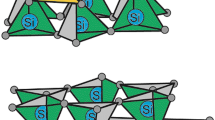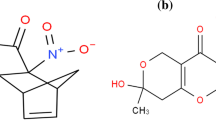Abstract
The present study examined the adsorption of cysteine, thiourea and thiocyanate on bentonite and montmorillonite at two different pHs (3.00, 8.00). The conditions used here are closer to those of prebiotic earth. As shown by FT-IR, Mössbauer and EPR spectroscopy and X-ray diffractometry, the most important finding of this work is that cysteine and thiourea penetrate into the interlayer of the clays and reduce Fe3+ to Fe2+, and as consequence, cystine and c,c′-dithiodiformamidinium ion are formed. This mechanism resembles that which occurs with aconitase. This is a very important result for prebiotic chemistry; we should think about clays not just sink of molecules, but as primitive vessels of production of biomolecules. At pH 8.00, an increasing expansion was observed in the following order for both minerals: thiourea > thiocyanate > cysteine. At pH 3.00, the same order was not observed and thiourea had an opposite behavior, being the compound producing the lowest expansion. Mössbauer spectroscopy showed that at pH 8.00, the proportion of Fe2+ ions in bentonite increased, doubling for thiourea, or more than doubling for cysteine, in both clays. However, at pH 3.00, cysteine and thiourea did not change significantly the relative amount of Fe2+ and Fe3+ ions, when compared to clays without adsorption. For thiocyanate, the amount of Fe2+ produced was independent of the pH or clay used, probably because the interlayers of clays are very acidic and HSCN formed does not reduce Fe3+ to Fe2+. For the interaction of thiocyanate with the clays, it was not possible to identify any potential compound formed. For the samples of bentonite and montmorillonite at pH 8.00 with cysteine, EPR spectroscopy showed that intensity of the lines due to Fe3+ decreased because the reaction of Fe3+/cysteine. Intensity of EPR lines did not change when the samples of bentonite at pH 3.00 with and without cysteine were compared. These results are in accordance with those obtained using Mössbauer and FT-IR spectroscopy.







Similar content being viewed by others
References
Alia MP, Matysik J (2001) Effect of proline on the production of singlet oxygen. Amino Acids 21:195–200
Augusto O, Vaz SM (2007) EPR spin-trapping of protein radicals to investigate biological oxidative mechanisms. Amino Acids 32:535–542
Basiuk VA (2002) Adsorption of biomolecules on silica. In: Somassundaran P (ed) Encyclopedia of surface and colloid science. Marcell-Dekker, New York, p 277
Bebié J, Schoonen MAA (2000) Pyrite surface interaction with selected organic aqueous species under anoxic conditions. Geochem Trans 1:47–53
Benetoli LOB, de Souza CMD, da Silva KL, de Souza IG Jr, de Santana H, Paesano A Jr, da Costa ACS, Zaia CTBV, Zaia DAM (2007) Amino acid interaction with and adsorption on clays: FT-IR and Mössbauer spectrometry and X-ray diffractometry investigations. Orig Life Evol Biosph 37:479–493
Benincasa E, Brigatti MF, Lugli C, Médici L, Poppi L (2000) Interaction between glycine and Na–, Ca–, and Cu-rich smectites. Clay Miner 35:635–641
Bernal JD (1951) The physical basis of life. Routledge and Kegan Paul, London
Bittner S, Gorohovsky S, Lozinsky E, Shames AI (2000) EPR study of radicals of various N-quinonyl amino acids. Amino Acids 19:439–449
Brigatti MF, Lugli C, Montorsi S, Poppi L (1999) Effects of exchange cations and layer-charge location on cysteine retention by smectites. Clays Clay Miner 47:664–671
Brigatti MF, Malferrari D, Médici L, Poppi L (2003) Effect of amino acids on the retention of copper by beidellite. Environ Eng Sci 20:601–606
Bron M, Holze R (1999) The adsorption of thiocyanate ions at gold electrodes from an alkaline electrolyte solution: a combined in situ infrared and Raman spectroscopic study. Electrochim Acta 45:1121–1126
Cowan JA (1993) Inorganic biochemistry an introduction. VCH, New York, pp 154–155
Darnell J, Lodish H, Baltimore D (1990) Molecular cell biology. Scientific American Books, New York, p 48
Dowler MJ, Ingmanson DE (1979) Thiocyanate in Red Sea brine and its implications. Nature 279:552
Fan JP, Kim HS, Han GD (2009) Induction of apoptosis by l-carnitine through regulation of two main pathways in Hepa1c1c7 cells. Amino Acids 36:365–372
Garcia G, Rodríguez JL, Lacconi GI, Pastor E (2004) Spectroscopic investigation of the adsorption and oxidation of thiourea on polycrystalline Au and Au(III) in acidic media. Languimuir 20:8773–8780
Greenland DJ, Laby RH, Quirk JP (1965) Adsorption of amino acids and peptides by montmorillonite and illite. Part 1: cation exchange and proton transfer. Trans Faraday Soc 61:2013–2023
Hazen RM (2006) Mineral surfaces and the prebiotic selection and organization of biomolecules. Am Miner 91:1715–1729
Lahav N, Chang S (1976) The possible role of solid surface area in condensation reactions during chemical evolution: reevalution. J Mol Evol 8:357–380
Lambert JF (2008) Adsorption and polymerization of amino acids on mineral surfaces: a review. Orig Life Evol Biosph 38:211–242
Martin-Neto L, Nascimento OR, Talamoni J, Poppi NR (1991) EPR of micronutrients-humic substances complexes extracted from Brazilian soil. Soil Sci 151:369–376
McBride M (1978) Transition metal bonding in humic acid: an ESR study. Soil Sci 126:200–209
Ng FTT, Henry PM (1975) Kinetics and mechanism of the oxidation of thiocyanate by tris(1, 10-phenathroline) iron (III) and its derivates. Can J Chem 53:3319–3326
Parker GK, Hope GA (2008) Spectroelectrochemical investigations of gold leaching in thiourea media. Miner Eng 21:489–500
Raulin F, Toupance G (1977) The role of sulphur in chemical evolution. J Mol Evol 9:329–338
Senesi N (1990) Molecular and quantitative aspects of the chemistry of fulvic acids and its interactions with metals ions and organic chemicals. Part I: the electron spin resonance approach. Anal Chim Acta 232:51–75
Siffert B, Kessaissia S (1978) Contribution au mecanisme d’adsorption des α-amino-acides par la montmorillonite. Clay Miner 13:255–270
Sposito G (1984) The surface chemistry of soils. Oxford University Press, New York
Talreja ST, Oza PM, Rao PS (1967) Radiation induced conversion of ammonium thiocyanate to thiourea. Bull Chem Soc Jpn 40:2427–2428
Wei M, Shi Z, Evans DG, Duan X (2006) Study on the intercalation and interlayer oxidation transformation of l-cysteine in a confined region of layered double hydroxides. J Mat Chem 16:2102–2109
Wen Z, Li M, Li Y, Guo Y, Wang K (2007) Delaunay triangulation with partial least squares projection to latent structures: a model for G-protein coupled receptors classification and fast structure recognition. Amino Acids 32:277–283
Yamaguchi A, Penland RB, Mizushima S, Lane TJ, Curran C, Quagliano JV (1958) Infrared absorption spectra of inorganic coordination complexes. XIV: infrared studies of some metal thiourea complexes. J Am Chem Soc 80:527–529
Yan M, Liu K, Jiang Z (1996) Electrochemical oxidation of thiourea studied by in situ FTIR spectroscopy. J Electroanal Chem 408:225–229
Zaia DAM (2004) A review of adsorption of amino acids on minerals: was it important for origin of life? Amino Acids 27:113–118
Zaia DAM, de Santana H, Toppan R, Zaia CTBV (2004) Synthesis of guanidine from ammonium thiocyanate in solid state. J Braz Chem Soc 15:190–198
Zaia DAM, Zaia CTBV, de Santana H (2008) Which amino acids should be used in prebiotic chemistry studies? Orig Life Evol Biosph 38:469–488
Acknowledgments
CMDS acknowledges the fellowship from PIBIC/CNPq/UEL. This research was supported by grants from CNPq (473076/2004) and Fundação Araucária (2421). Dr. A. Leyva provided English editing of the manuscript.
Author information
Authors and Affiliations
Corresponding author
Rights and permissions
About this article
Cite this article
de Santana, H., Paesano, A., da Costa, A.C.S. et al. Cysteine, thiourea and thiocyanate interactions with clays: FT-IR, Mössbauer and EPR spectroscopy and X-ray diffractometry studies. Amino Acids 38, 1089–1099 (2010). https://doi.org/10.1007/s00726-009-0318-8
Received:
Accepted:
Published:
Issue Date:
DOI: https://doi.org/10.1007/s00726-009-0318-8




